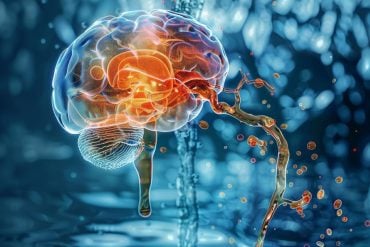Summary: Researchers report bile acids play a key role in providing positive metabolic effects after weight loss surgery. The study also suggest the intestinal microbiome participates in post surgical improvements following gastric bypass. The findings could help develop new treatments for diabetes and obesity, researchers report.
Source: Vanderbilt University.
A team of Vanderbilt investigators has pinpointed the role of bile acids and a specific signaling pathway in the positive metabolic effects of weight-loss surgery.
The findings, reported in the journal Gastroenterology, also suggest that the intestinal microbiome participates in post-surgery improvements. The results could guide new treatment strategies for obesity and diabetes, which continue to climb in the American population.
Bariatric surgery—weight-loss operations that include gastric bypass—is much more effective than intensive medical therapy for obesity and diabetes, and metabolic benefits can happen within days, before weight loss occurs.
“Surgical patients can experience dramatic changes in glucose regulation while they are still in the recovery room,” said Charles (Robb) Flynn, Ph.D., associate professor of Surgery. “These operations cause metabolic changes that we don’t really understand.”
In previous studies, Flynn, Naji Abumrad, MD, John L. Sawyers Professor of Surgical Sciences, and others found increased levels of serum bile acids, gut compounds that help digest dietary fats, after two common bariatric operations—Roux-en-Y gastric bypass and vertical sleeve gastrectomy.
Roux-en-Y gastric bypass, which is one of the most commonly performed weight-loss procedures, restricts the size of the stomach, alters the path of food through the digestive tract and changes the point where bile acids enter the small intestine, from the usual upper part of the small intestine to a site near the end.
Flynn and Abumrad worked with the Vanderbilt Mouse Metabolic Phenotyping Center to develop a simpler surgical procedure in mice that mimics the Roux-en-Y re-routing of bile acids. The procedure, called bile diversion, increases bile acids in the blood and produces all of the beneficial effects of bariatric surgery: weight loss, reduced food intake and improved oral glucose tolerance, Flynn said.
In addition to aiding fat absorption and digestion, bile acids activate signaling pathways through two types of receptors: Tgr5 and Fxr.
In studies led by research fellow Vance Albaugh, MD, Ph.D., the investigators discovered that in mice missing Tgr5, bile diversion surgery still produced beneficial metabolic effects. In mice missing intestinal Fxr, however, bile diversion surgery no longer improved oral glucose tolerance.
“Our study shows specifically that elevated bile acids following bariatric surgery work through the Fxr receptor, and that it functions in the intestine,” Flynn said.
The team further found that improvements in glucose handling were accompanied by increased levels of both GLP-1 (glucagon-like peptide-1) and the intestinal bacteria Akkermansia muciniphila, and that the GLP-1 receptor was required for the beneficial effects of bariatric surgery. GLP-1 is a hormone that participates in regulating blood glucose.
“Our mouse model of bariatric surgery has allowed us to isolate the metabolic effects of bile acids and show that improvements in oral glucose handling require an Fxr-GLP-1 receptor signaling pathway,” Flynn said.
The change in one species of intestinal bacteria is also intriguing, Flynn said. Akkermansia muciniphila is associated with lean phenotypes in animal models and human beings.

“Our discovery raises the idea that finding a way to introduce this bacterium into people might have weight loss and beneficial metabolic effects,” Flynn said. “There’s a very tight interplay between bacteria in the gut, bile acids and metabolic effects. We’re just beginning to tease this apart.”
Flynn and his colleagues are continuing to explore metabolic changes following bariatric surgery in their surgical mouse model. They have also begun to study patients at the Vanderbilt Weight Loss Center to explore whether the mechanisms they’ve discovered in mice also hold true in people.
“We want to fully understand how the surgery is generating beneficial metabolic changes so that we can improve treatments for obesity and diabetes,” Flynn said.
Source: Vanderbilt University
Publisher: Organized by NeuroscienceNews.com.
Image Source: NeuroscienceNews.com image is in the public domain.
Original Research: Abstract for “Role of Bile Acids and GLP-1 in Mediating the Metabolic Improvements of Bariatric Surgery” by Vance L. Albaugh, Babak Banan, Joseph Antoun, Yanhua Xiong, Yan Guo, Jie Ping, Muhammed Alikhan, Blake Austin Clements, Naji N. Abumrad, and Charles Robb Flynn in Gastroenterology. Published November 13 2018.
doi:10.1053/j.gastro.2018.11.017
[cbtabs][cbtab title=”MLA”]Vanderbilt University “Bile Acids Mediate Metabolic Benefits of Weight Loss Surgery.” NeuroscienceNews. NeuroscienceNews, 12 January 2019.
<https://neurosciencenews.com/bile-acid-metabolism-10518/>.[/cbtab][cbtab title=”APA”]Vanderbilt University(2019, January 12). Bile Acids Mediate Metabolic Benefits of Weight Loss Surgery. NeuroscienceNews. Retrieved January 12, 2019 from https://neurosciencenews.com/bile-acid-metabolism-10518/[/cbtab][cbtab title=”Chicago”]Vanderbilt University “Bile Acids Mediate Metabolic Benefits of Weight Loss Surgery.” https://neurosciencenews.com/bile-acid-metabolism-10518/ (accessed January 12, 2019).[/cbtab][/cbtabs]
Abstract
Role of Bile Acids and GLP-1 in Mediating the Metabolic Improvements of Bariatric Surgery
Background and Aims
Bile diversion to the ileum (GB-IL) has strikingly similar metabolic and satiating effects to Roux-en-Y gastric bypass (RYGB) in rodent obesity models. The metabolic benefits of these procedures are thought to be mediated by increased bile acids, though parallel changes in body weight and other confounding variables limits this interpretation.
Methods
Global G protein-coupled bile acid receptor-1 null (Tgr5-/-) and intestinal-specific farnesoid X receptor null (FxrΔ/E) mice on high-fat diet as well as wild-type C57BL/6 and glucagon-like polypeptide 1 receptor deficient (Glp-1r-/-) mice on chow diet were characterized following bile diversion to the ileum (GB-IL).
Results
GB-IL induced weight loss and improved oral glucose tolerance in HFD-fed Tgr5-/-, but not FxrΔ/E mice, suggesting a role for intestinal Fxr. GB-IL in wild-type, chow-fed mice prompted weight-independent improvements in glycemia and glucose tolerance secondary to augmented insulin responsiveness. Improvements were concomitant with increased levels of lymphatic GLP-1 in the fasted state and increased levels of intestinal Akkermansia muciniphila. Improvements in fasting glycemia after GB-IL were mitigated with Ex-9, a GLP-1 receptor antagonist, or cholestyramine, a bile acid sequestrant. The glucoregulatory effects of GB-IL were lost in whole body Glp-1r-/- mice.
Conclusions
Bile diversion to the ileum improves glucose homeostasis via an intestinal Fxr-Glp-1 axis. Altered intestinal bile acid availability, independent of weight loss, and intestinal Akkermansia muciniphila appear to mediate the metabolic changes observed after bariatric surgery and might be manipulated for treatment of obesity and diabetes.






